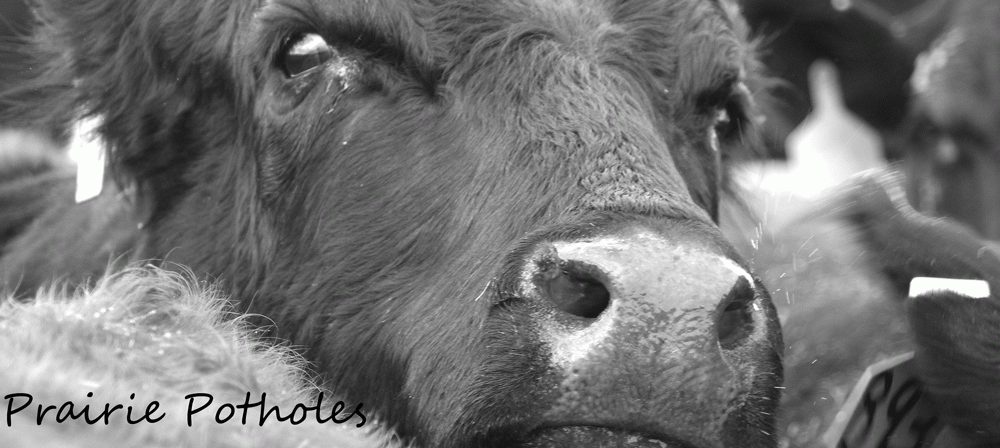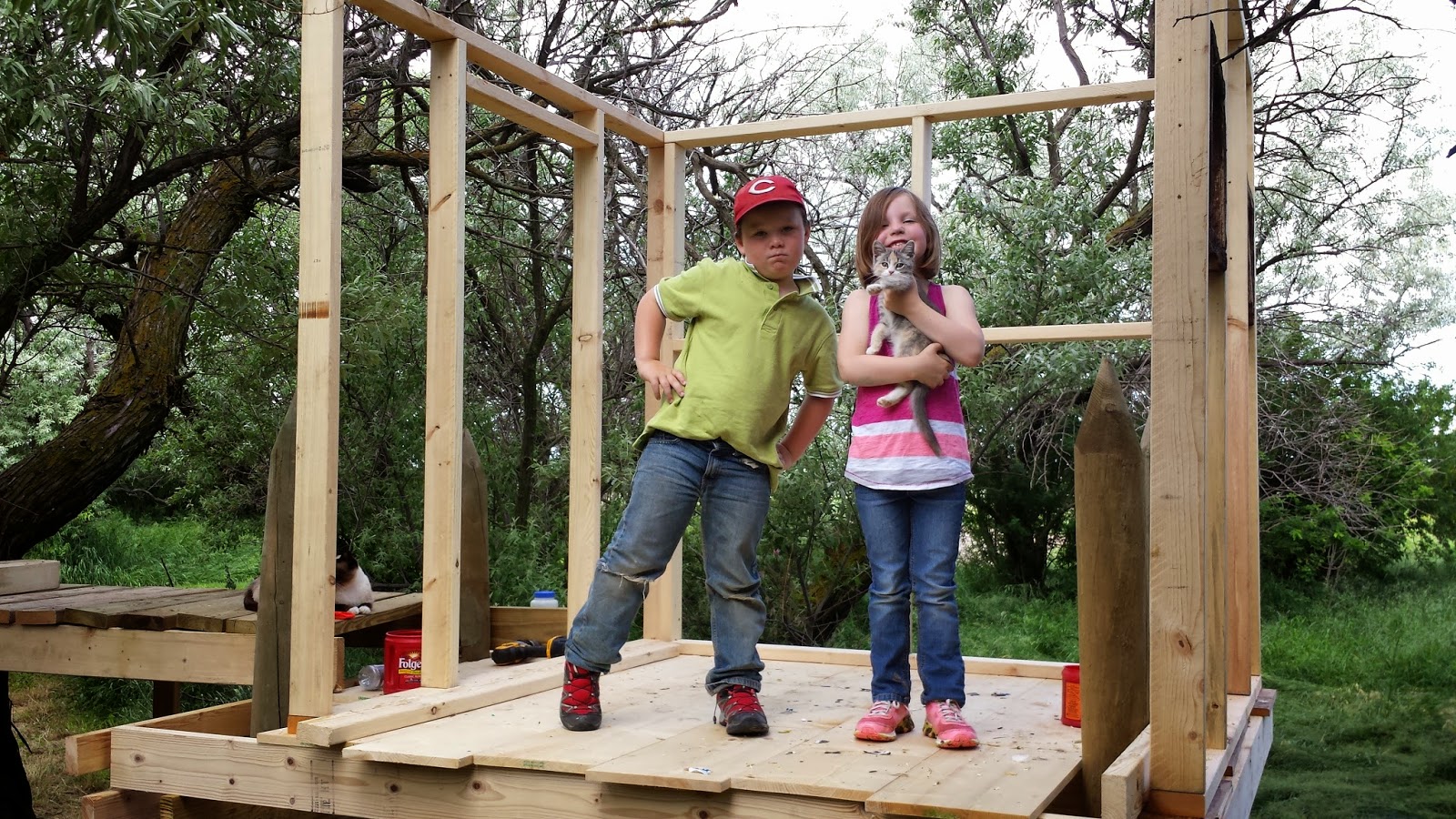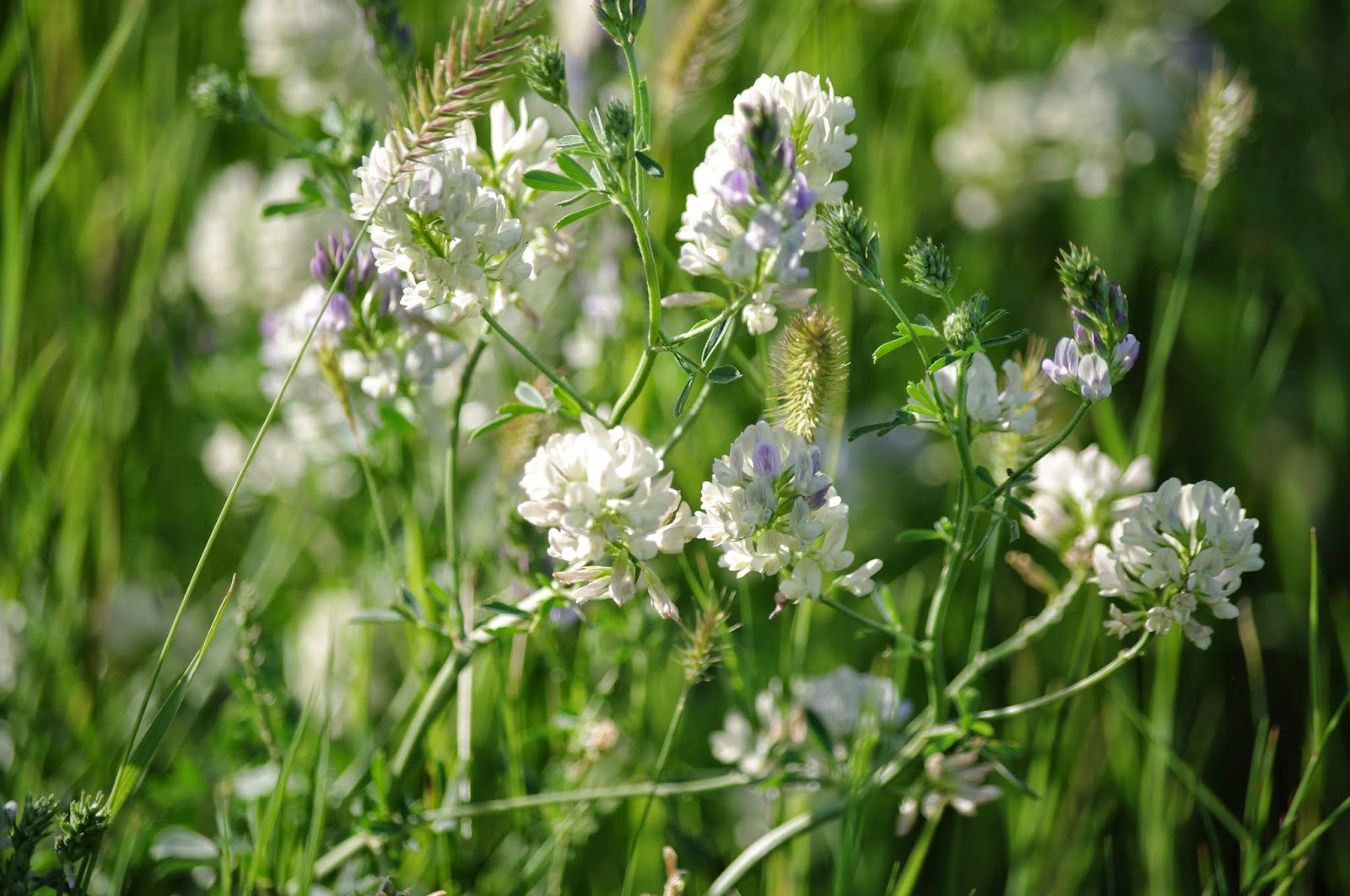Ah, summer. It's been a good one. Life with infants and toddlers is nothing compared to life with two school age children who have blossoming imaginations and interests. So when they jokingly told us they wanted a treehouse, we ran with that idea.
I've been reminded (by the children) that the kitchen remodel project from this past winter isn't quite complete and they think maybe I should finish it because I have a sink, paint and tile piled in the corner of that room. The kitchen will wait. Treehouses are way more vital to their imagination than a cool countertop.
We roamed the tree grove looking for the perfect place to locate this treehouse. Yet again, I was reminded that I live on the prairie and while we are fortunate to have so many trees surrounding our home, not a single one is conducive to supporting an entire structure that I would have confidence in. We ultimately chose a building site right next to the one chosen by Danish Cowboy in his younger days for a treehouse. My kids can look 10 feet off to the east and see how their dad spent his summertime youth. We began building then promptly found a baby rattlesnake that wanted to call this spot home. I nearly cried because tamping those posts just about did me in and the thought of moving them was painful.
We soldiered on, rattlesnake or not, and settled on a modified version of a treehouse with a walkway connected to a tree and the platform soundly supported by large wood posts originally intended for a fencing project. There is not a piece of wood on the farm that is safe from me this summer. I perfected my use of the power saw, hammer, drill, level and tape measure. Kind of. And when I had the walls erected, it swayed beautifully in the wind. The nightmares of a crumbling treehouse began.
I retreated to the kitchen (unfinished) and started reading about the power of triangles and their value in providing support. I can't tell you how pleased I was to learn that, yes, a2 + b2 still does equal c2.
I really do love math. Let me say that again: I LOVE MATH!
Fractions, geometry, trigonometry, algebra. There is a purpose for it. And for me, this treehouse is it! I've admittedly gotten a little sloppier with measurement as time goes on. And there is no roof yet. And the warped barn wood on portions of the building have caused a little grief. But the cantilevers and awesome right triangles make up for those flaws.
Like any good do-it-yourselfer, all the kids care about is the color of the thing. I have taught them well. And so we will soon have a barn red, lime green, turquoise, orange and spiderman blue structure where imaginations can soar!
Admittedly, at the rate we are getting it painted, the children will be off to college by the time it is done. But that's okay. Spending time hanging out in this structure, the repeated trips back and forth to the shop and our power source, the birds flitting all around us...I'm not really in a hurry to be done with this because the kids will look back on this time many decades from now and say "remember the summer we helped build that treehouse..." This is the stuff that memories are made of.
Of course they'll probably also look back in a few decades when they are cleaning up the remnants of this treehouse and say "why the hell did she use so many screws?" It's a legacy. I'm leaving them a legacy.
Tuesday, August 5, 2014
Saturday, July 19, 2014
The Sweet Smell of Summer
"My candle burns at both ends
It will not last the night;
But ah, my foes, and oh, my friends -
It will not last the night;
But ah, my foes, and oh, my friends -
it gives a lovely light."
~Edna St. Vincent Millay
I've been repeating this line memorized in high school English quite often to myself these past few weeks. It is the life that we live. And it is only briefly during the summer months that we need to live this way. So we enjoy the exhaustion, the lack of downtime and the never-ending saga of work that defines our lives once haying season begins. It is but once a year that we can reap this harvest and the prime season for cutting hay only lasts so long. There will be time to rest this winter.Make hay while the sun shines, don't ya know?
We've been in full-fledged haying mode for a little over two weeks now. We cut a variety of different species and roll them up into large round bales: hay barley, peas, crested wheatgrass, tall wheatgrass, alfalfa and various mixes of those. And with years such as this, there is bound to be a bit of yellow sweetclover in the mix as well, though not by design.
My favorite of all of these species is by far the alfalfa. I love looking at the colors. When it blooms, the vast majority of flowers take on a bright purple shade. But there are other colors as well: the bluish color in the picture above, whites, dark (almost black) violet, yellows. It is fun to wander the fields and see what unique shade variations can be found.
Alfalfa (medicago sativa) is not native to the United States, but it has over time become the most important hay crop that is grown in the northern and western states.
The species has its origins in the Persia region and has been cultivated for livestock feed since the days of the Greeks and Romans.
It was introduced to this side of the Atlantic with invading conquerors and explorers who required fodder for their horses. Since then, research universities have the spent the greater part of the 20th Century developing new varieties of this perennial that are tolerant to drought, insects, a variety of soil types and that have a high rate of production. In many areas, especially those with irrigation, the crop can be harvested 3 or 4 times per year. However, our stands of alfalfa are on dry land areas and because the growing season is so short and the recovery time prior to frost is so long, we only harvest once per year.
Our haying season will continue on for another week or so then we will transition over to the harvest of peas, wheat and barley. The sweet smell of freshly cut alfalfa will linger on, though. When we break open the bales this winter it will be a tough person that can't find fulfillment in reliving the smell of summer that then seems so distant.
We awoke this morning to skies not quite so blue as this. The winds have carried the smoke from the fires in northern Canada and it blankets our valley, or rather it blankets the entire northwest and upper Midwest in smoke. The world is now not quite so breathtaking with the gray gloom hovering over us. The colors of green and shades of purple are not quite so brilliant. The air is not quite so sweet. We are reminded on days like these that when we put our heads down and work the land, we are not alone. What we do here has far ranging impacts across the world just as those fires 1,000 miles away have affected us. Geographical boundaries are relevant only to man and only when conflict arises. No man is an island. And for that matter, no landscape is either.
Wednesday, March 26, 2014
Magical
A few short weeks ago we were not terribly busy as February is filled with the feeding of cows and the avoidance of crazy cold weather. So we hopped in our vehicle and headed southwest for an extended weekend in West Yellowstone. The high that day as we drove across the prairie and west of the Crazy Mountains was certainly not more than about -12 degrees.
On Friday morning, an almost equally cold day, we bundled and up and boarded a snowcoach for a unique adventure into the Yellowstone caldera. We saw wildlife, thermo features and of course the Old Faithful show. As a friend put it to me when we returned, "Yellowstone is a magical place in the winter."
And it was.
Then we came home, wrestling season started, the calves started arriving and my anticipated winter-time blog post is now more of a spring memory.
However, the past few weeks have left me thinking quite a bit about the majesty of Yellowstone and the wildness that you find there. You hear in the news quite a bit these days about the tragedy of the Yellowstone bison and why the environmentalists are hazing them back in to the park to prevent them from being hunted or rounded up and hauled away. They cry foul against the ranchers.
Being married to a farmer and rancher, and being the good environmentalist that I was trained to be (though not the tree-hugging chain myself to a bulldozer type of greenie), I cringe when they paint an evil portrait of the modern day agriculturalist.
I hate it when they do that. It makes me feel bad about myself.
Because you see, what the other side of the argument doesn't realize is how closely we live on the fringe of wildness out here. More often than not, we are immersed in the wildness and we prefer it that way.
Our cattle are not pets. They are responsible for raising a calf from birth to weaning and they are often left alone for days on end to accomplish this task. We preserve the wild instinct (though preferably not the "attack the human" urge) in them to defend that calf against the other forces of nature. Our fields and our forage are also living on the edge of wildness. True, there are farmers out there who try to obliterate nature into submission with the indiscriminate use of pesticides, but most of us are responsible with our choices. No matter what methods a farmer uses, the nature of soil is to return to a native climax community, both with the flora and with the micro-organisms below the surface. If those that cry foul on agriculture would only realize how in sync we are with wildness, and how our success depends on respecting the world around us, they might not put out such a strong argument that hurts my feelings.
To think that we as humans can single-handedly turn the wheel of nature is foolish. We are but one cog in that wheel and the sum of the parts is more powerful than our one role.
So while we don't have the thermogeological features and charismatic megafauna that make Yellowstone so magical, the wildness that we integrate ourselves with out here in flyover country is every bit as captivating.
On Friday morning, an almost equally cold day, we bundled and up and boarded a snowcoach for a unique adventure into the Yellowstone caldera. We saw wildlife, thermo features and of course the Old Faithful show. As a friend put it to me when we returned, "Yellowstone is a magical place in the winter."
And it was.
Then we came home, wrestling season started, the calves started arriving and my anticipated winter-time blog post is now more of a spring memory.
However, the past few weeks have left me thinking quite a bit about the majesty of Yellowstone and the wildness that you find there. You hear in the news quite a bit these days about the tragedy of the Yellowstone bison and why the environmentalists are hazing them back in to the park to prevent them from being hunted or rounded up and hauled away. They cry foul against the ranchers.
Being married to a farmer and rancher, and being the good environmentalist that I was trained to be (though not the tree-hugging chain myself to a bulldozer type of greenie), I cringe when they paint an evil portrait of the modern day agriculturalist.
I hate it when they do that. It makes me feel bad about myself.
Because you see, what the other side of the argument doesn't realize is how closely we live on the fringe of wildness out here. More often than not, we are immersed in the wildness and we prefer it that way.
Our cattle are not pets. They are responsible for raising a calf from birth to weaning and they are often left alone for days on end to accomplish this task. We preserve the wild instinct (though preferably not the "attack the human" urge) in them to defend that calf against the other forces of nature. Our fields and our forage are also living on the edge of wildness. True, there are farmers out there who try to obliterate nature into submission with the indiscriminate use of pesticides, but most of us are responsible with our choices. No matter what methods a farmer uses, the nature of soil is to return to a native climax community, both with the flora and with the micro-organisms below the surface. If those that cry foul on agriculture would only realize how in sync we are with wildness, and how our success depends on respecting the world around us, they might not put out such a strong argument that hurts my feelings.
To think that we as humans can single-handedly turn the wheel of nature is foolish. We are but one cog in that wheel and the sum of the parts is more powerful than our one role.
So while we don't have the thermogeological features and charismatic megafauna that make Yellowstone so magical, the wildness that we integrate ourselves with out here in flyover country is every bit as captivating.
Subscribe to:
Comments (Atom)





























